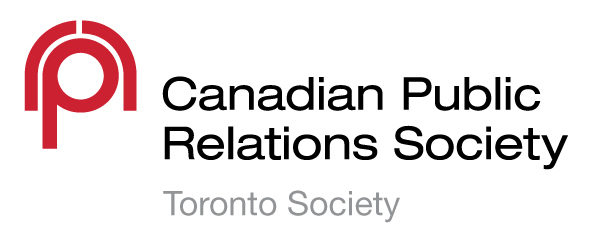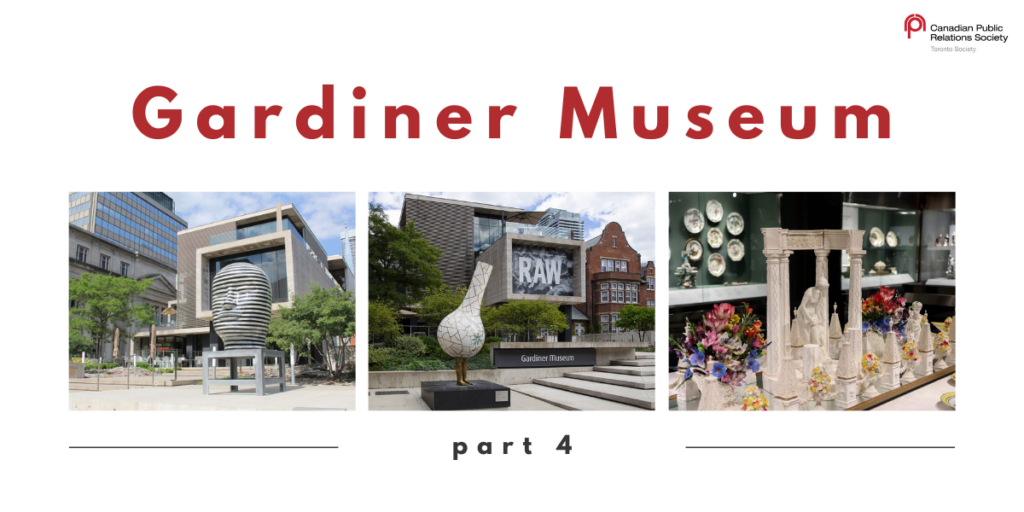Written by: Carolina Salinas, public relations and corporate communications graduate, Professional Development Inclusion & Equity Co-Chair, CPRS Toronto
Are you still unsure about the precise role of public relations within museums? In part four of our series “The Role of Public Relations within GLAMs during the COVID-19 lockdown”, we interviewed the Gardiner Museum’s Senior Marketing Manager!
Gardiner Museum
The Gardiner is one of a few museums in the world that specializes in ceramics. Recognized worldwide as a centre where creativity and community converge through the history of clay and ceramics, it is a place that engages audiences with exhibitions and programs inspired by its permanent collection and temporary displays.
The Gardiner contributes greatly to building community by connecting ceramics to the broader world and generating meaningful discussion. Its mission revolves around making, looking, and thinking through clay. From this perspective, public relations is a key element in promoting the work of this innovative museum.
In an interview with the Gardiner Museum’s Senior Marketing Manager, Rachel Weiner, she mentioned that public relations and earned media coverage are vital aspects of the Museum’s public relations and marketing strategy.
“As a small- to midsize museum with a limited advertising budget, we rely on media coverage of our exhibitions and programs to spread awareness and to attract visitors,” said Weiner. “We find that articles and reviews often drive more traffic than paid advertising, so while print and digital ads are an important part of our marketing formula, public relations often results in a greater return on investment.”
She added that the Gardiner’s ability to entice editors, journalists, bloggers, and social media influencers depends on the content of its exhibitions and its programs being timely, thought-provoking, and original.
According to Gardiner’s latest Annual Report, the Marketing Department designed and implemented a series of successful print, digital, and media relations campaigns in 2019 to promote the Gardiner’s exhibitions, education programs, and special events. This reflects its commitment to presenting content and material in innovative and exciting new ways.
A major challenge that the Museum’s public relations and marketing team has to deal with is its lack of financial resources. The Gardiner is classified both as a museum and a not-for-profit organization. Nevertheless, this situation also offers both advantages and disadvantages to Gardiner as a creative centre.
“The Gardiner handles public relations in-house, and we don’t have the budget to stage elaborate media previews or events,” said Weiner. “On the other hand, I find that the media are often receptive to our pitches. There are so many genuinely fascinating and important things happening in the arts—we’re engaging with the most pressing social and environmental issues. I think that makes the media receptive to us. They’re looking for unique and topical stories, and museums are able to provide that content.”
The GLAMs sector is widely known for its collaboration with other cultural institutions locally and sometimes internationally, and the Gardiner Museum is no exception. This creative and community-driven centre has generated engagement through partnerships with the Art Gallery of Ontario (AGO), Royal Ontario Museum (ROM), Aga Khan Museum, Bata Shoe Museum, and Textile Museum of Canada.
“We’re also part of a wonderful network called the Bloor St Culture Corridor that allows us to engage in joint promotion with neighbouring arts organizations like the Japan Foundation, Tafelmusik, The Royal Conservatory of Music, and Hot Docs Ted Rogers Cinema,” said Weiner. “While we’re all incredibly busy and working with limited resources, when we are able to find the time to strategize together, it’s always worth the effort. Particularly for arts institutions, where budgets and staff teams are generally small, leveraging each other’s audiences is a valuable tool. We tend to find that those who enjoy one museum or cultural activity will be open to exploring others.”
According to Weiner, the Gardiner has been forced to once again close temporarily after a brief reopening over the summer. Even though there are no in-person events at the moment, and although they cannot invite the media to the museum, they have been active on social media and other digital platforms, as well as updating their communities regularly through their e-newsletters. They have continued to reach out to the media with interesting story ideas, tailoring their pitches to fit the current moment by addressing wellness and isolation themes.
Weiner added that it’s vital that when they reach out to the media, they offer as much information as possible in the form of press releases, image galleries, digital catalogues, and exhibition text.
“We’ve also had to rethink the kind of stories we pitch since they should relate to something that readers can engage with online while the Museum is closed. It’s certainly a challenge,” said Weiner. “Right now, we’re taking time to work on our exhibitions and programming, in addition to taking care of our communities, including staff. When the Museum reopens, we’ll once again dedicate more time to public relations.”
What are the challenges facing the Gardiner Museum for 2021?
Weiner mentioned that there’s still a lot of uncertainty around when the Museum will reopen and when visitors will feel comfortable returning to the galleries in significant numbers:
“We have so many exciting exhibitions and programs in the works, and it’s really difficult not knowing whether they’ll be able to happen as planned and on schedule. Of course, this is compounded by the revenue concerns that we’re all facing. Without admissions, events, classes, and rentals, our ability to deliver world-class programming is at risk.”
Nevertheless, the Marketing team feels confident that the lockdown is something they can weather despite the challenges.

